What Is a Niche Market?
A niche market is a segment of a larger market with unique needs, preferences, or interests. These markets often have a small but specific target audience with common interests or traits.
Niche markets often have very specific needs that mass-market brands don’t address. In the example below, the niche market may be an audience of eco-conscious pet owners.
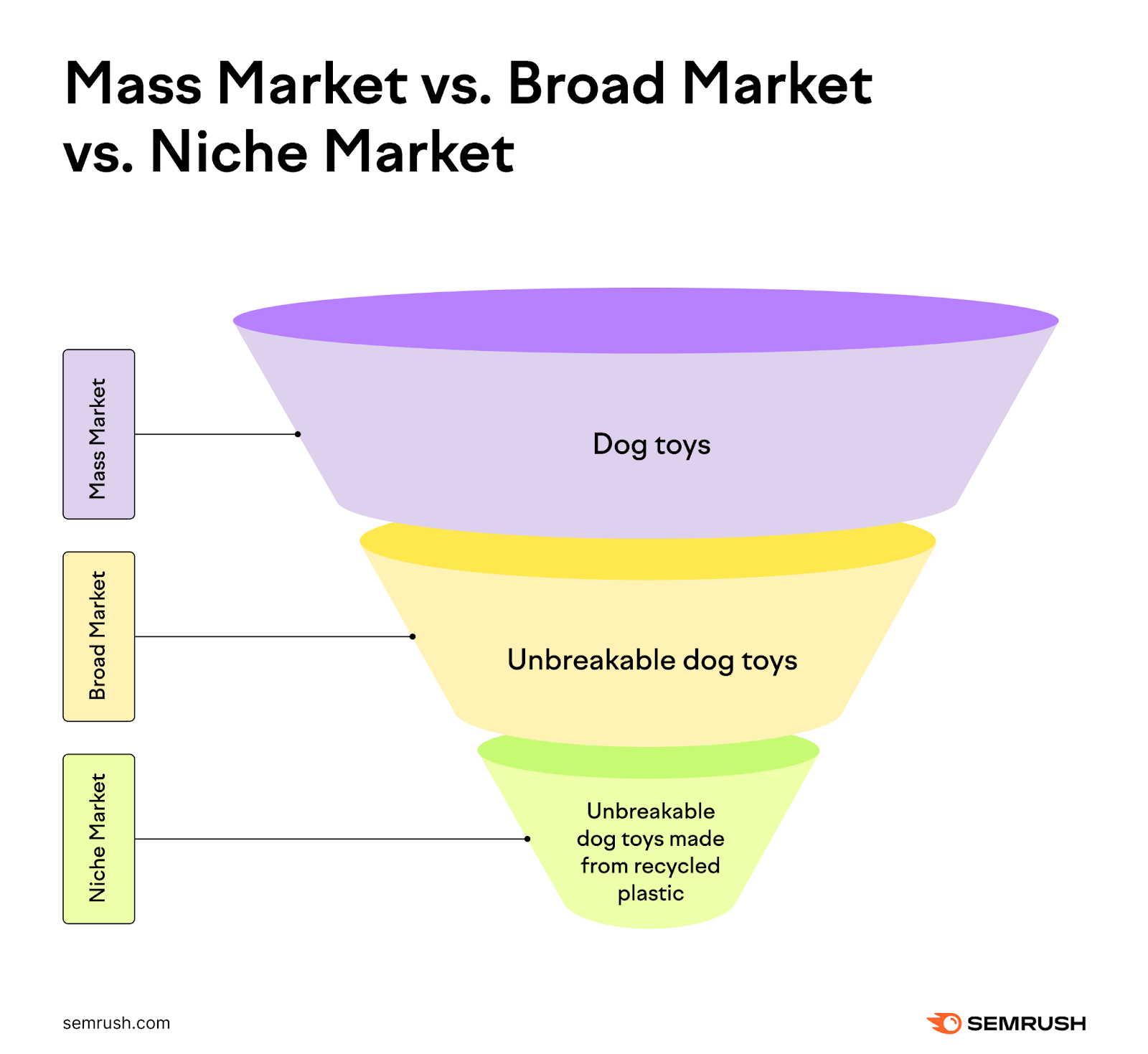
They might be looking for very specific toys only made from 100% recycled materials. The broader toy market might offer some solutions. But they’ll often need to seek out brands in their niche market to get exactly what they need.
For example, here are the search results in Google for the broad term “ toys”:
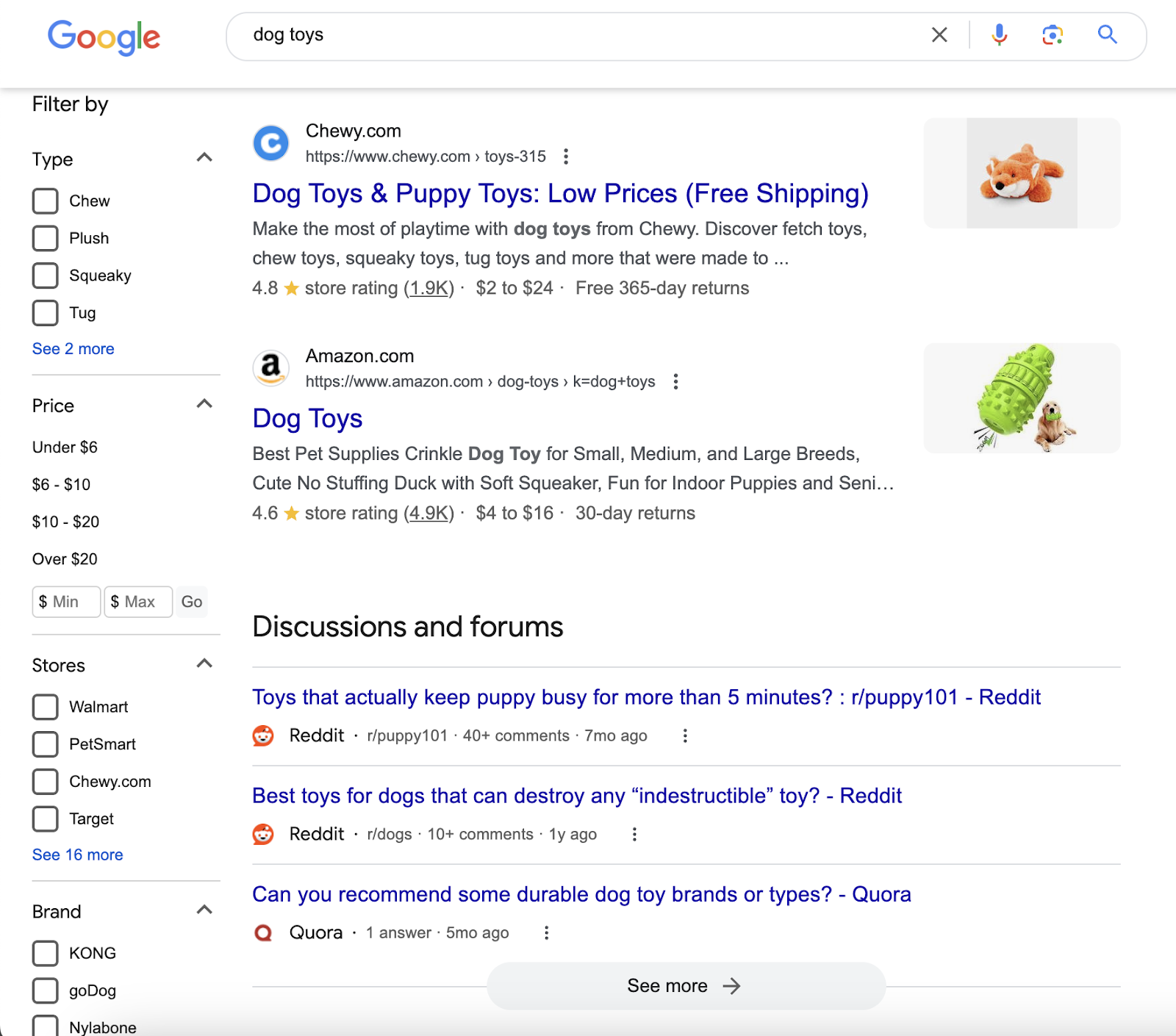
Compare that to the search results for a more specific term suited to their needs, “eco friendly toys”:
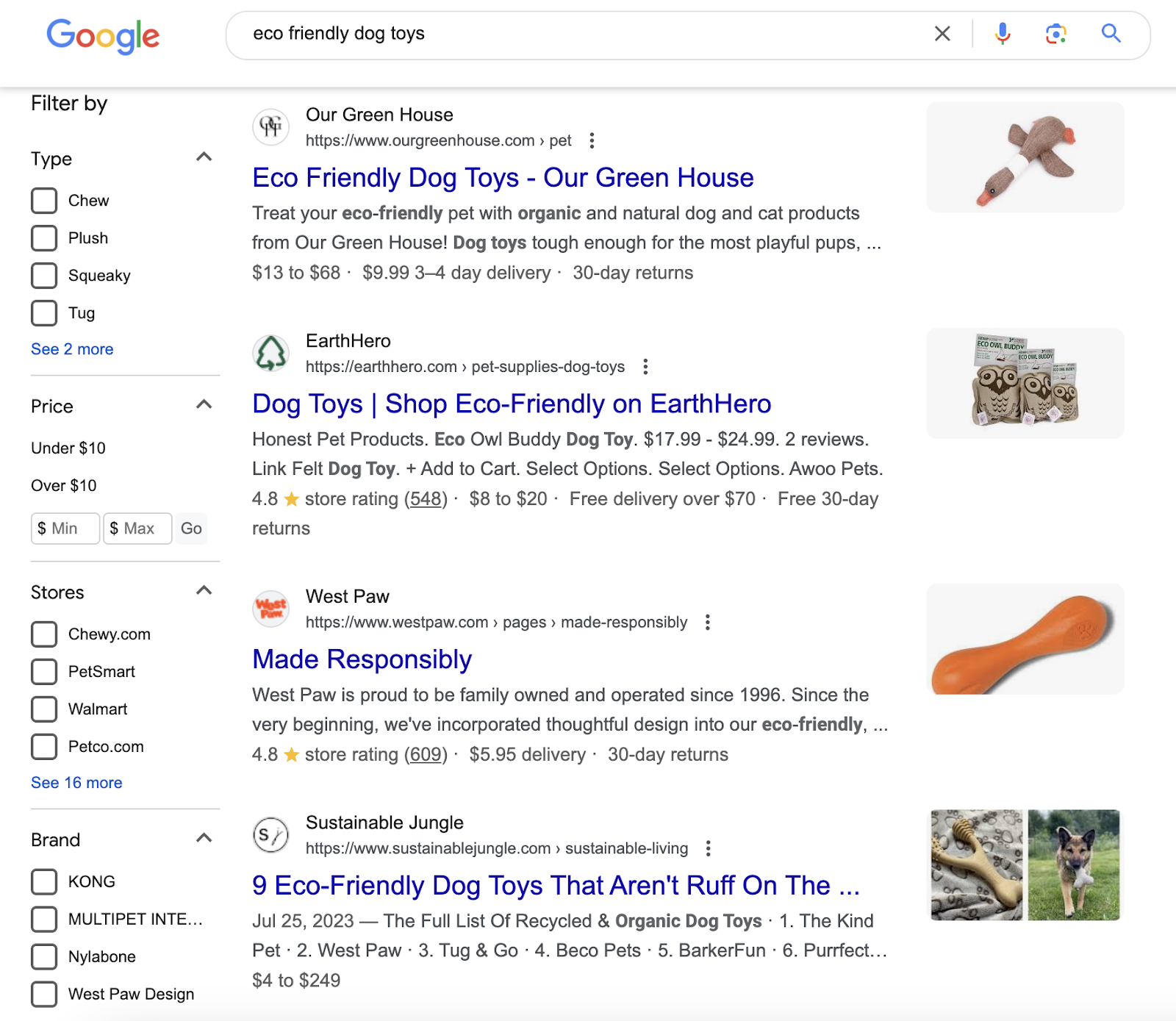
These results are from businesses in their niche market. That provide solutions tailored to their specific pain points.
But what does the business get out of this?
The Benefits of Targeting a Niche Market
Businesses in niche markets can take advantage of the following:
Reduced Marketing Costs
Targeting a wide market typically requires a big budget if you want to be successful. Targeting a niche market focuses your resources on the potential customers most likely to convert.
This applies no matter which marketing strategies you use. Whether it’s creating highly targeted segments with paid advertising campaigns. Or running keyword-focused SEO campaigns.
Lower Competition
Niche markets are often less competitive. Making it easier for new businesses to penetrate the market and even become a market leader.
Consider the apparel and fashion industry (a very broad market). Here is a market summary from Semrush’s Market Explorer tool:
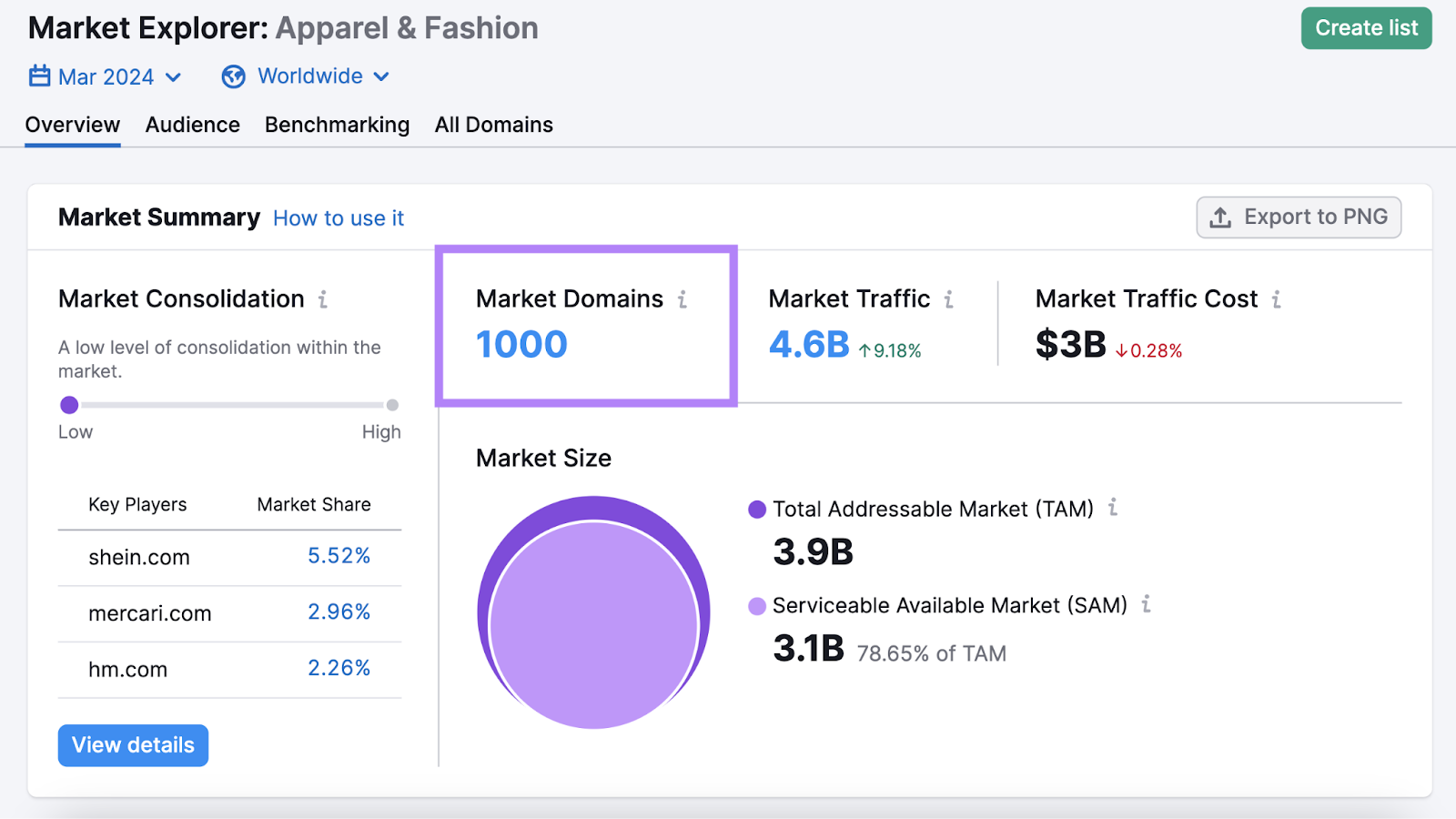
And here is the market summary for Ties.com, a site that specializes in men’s accessories:
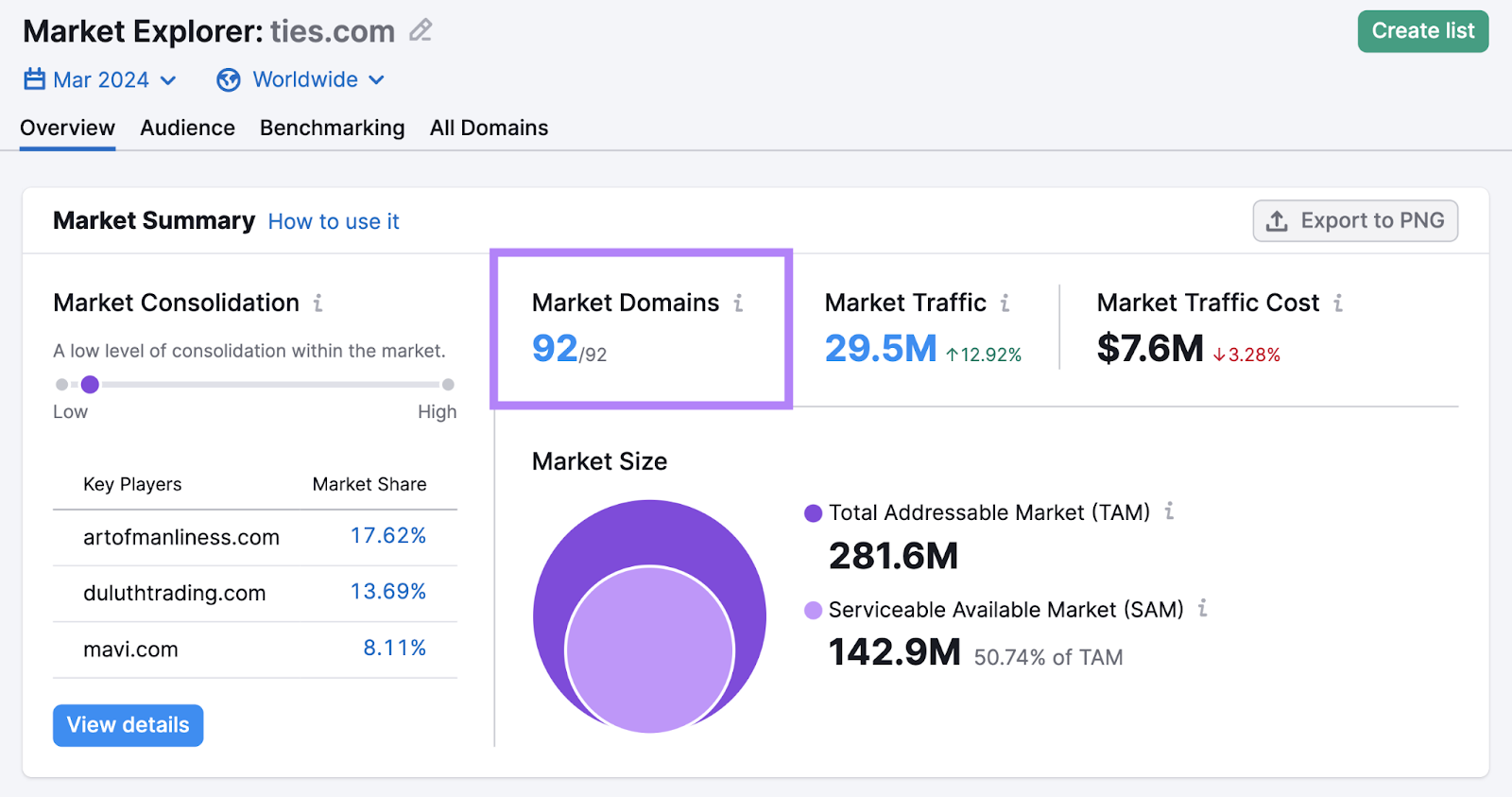
It’s a niche market within the broader fashion market. And this shows in the numbers. There are far fewer competitors in the brand’s niche market, with 94 domains compared to 1,000+ for the broader market.
Reaching a Passionate Audience
Many niche markets include highly passionate consumers who are eager to try new products. With some willing to pay a premium price to solve their unique problems.
That can make niche markets lucrative, despite the smaller target audience. Buyers in these markets have specific problems that mass market brands might not be able to cater to.
Low supply and strong demand (even from a smaller overall audience) can therefore mean increased profitability for businesses that can effectively solve niche market problems.
Increased Brand Loyalty
Niche markets also offer an opportunity to please your customers and solve their pain points more effectively.
This makes it easier for businesses to build brand loyalty. Because your customers are more likely to keep coming back if you provide them with exactly what they need.
4 Ways to Find Your Niche Market
The ideal niche market is made up of passionate people with few competing businesses. And it’s one in which you can use your specific expertise to solve customer pain points.
Here are four ways to find your niche market:
1. Do Keyword Research
Keyword research isn’t just useful for SEO campaigns. It can also help you find niche marketing ideas by showing you what people are actually searching for.
Proper keyword research will help you determine the following:
- What people are searching for
- How often people are searching for these terms
- Related queries you may have overlooked
Start your keyword research using Semrush’s Keyword Magic Tool. Simply enter a keyword related to your broad market and hit “Search.”
For this example, let’s use “baked goods” as our broad market.

You’ll get a list of keywords related to “baked goods.” You might already see one or two niche marketing terms in there, like “gluten free baked goods.”
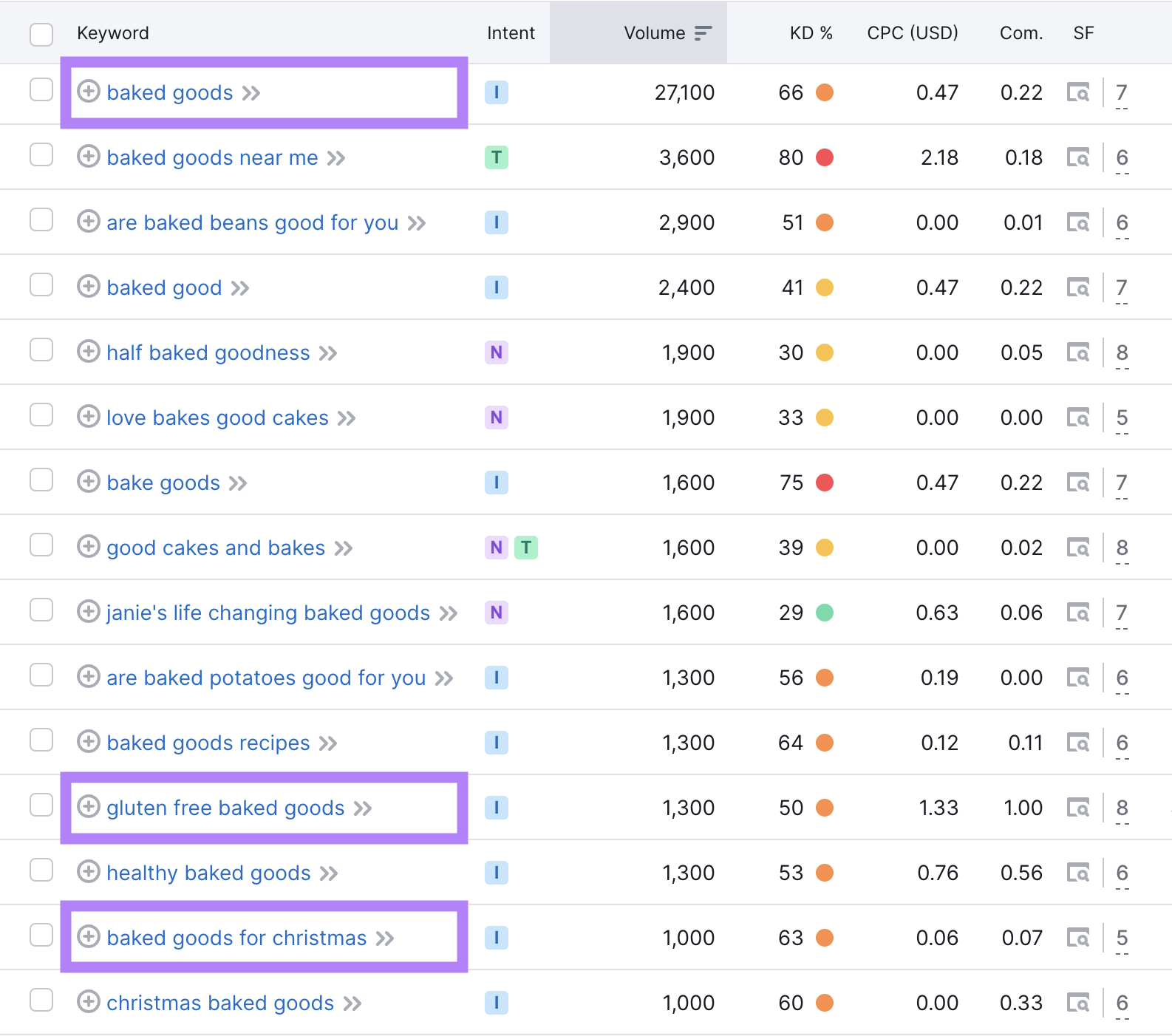
But you can niche down even further, and find keywords with lower competition. First, change the keyword difficulty range to 0-49% to target easier terms.
Do this by clicking the “KD %” filter and entering 0 to 49 in the “Custom range” section.
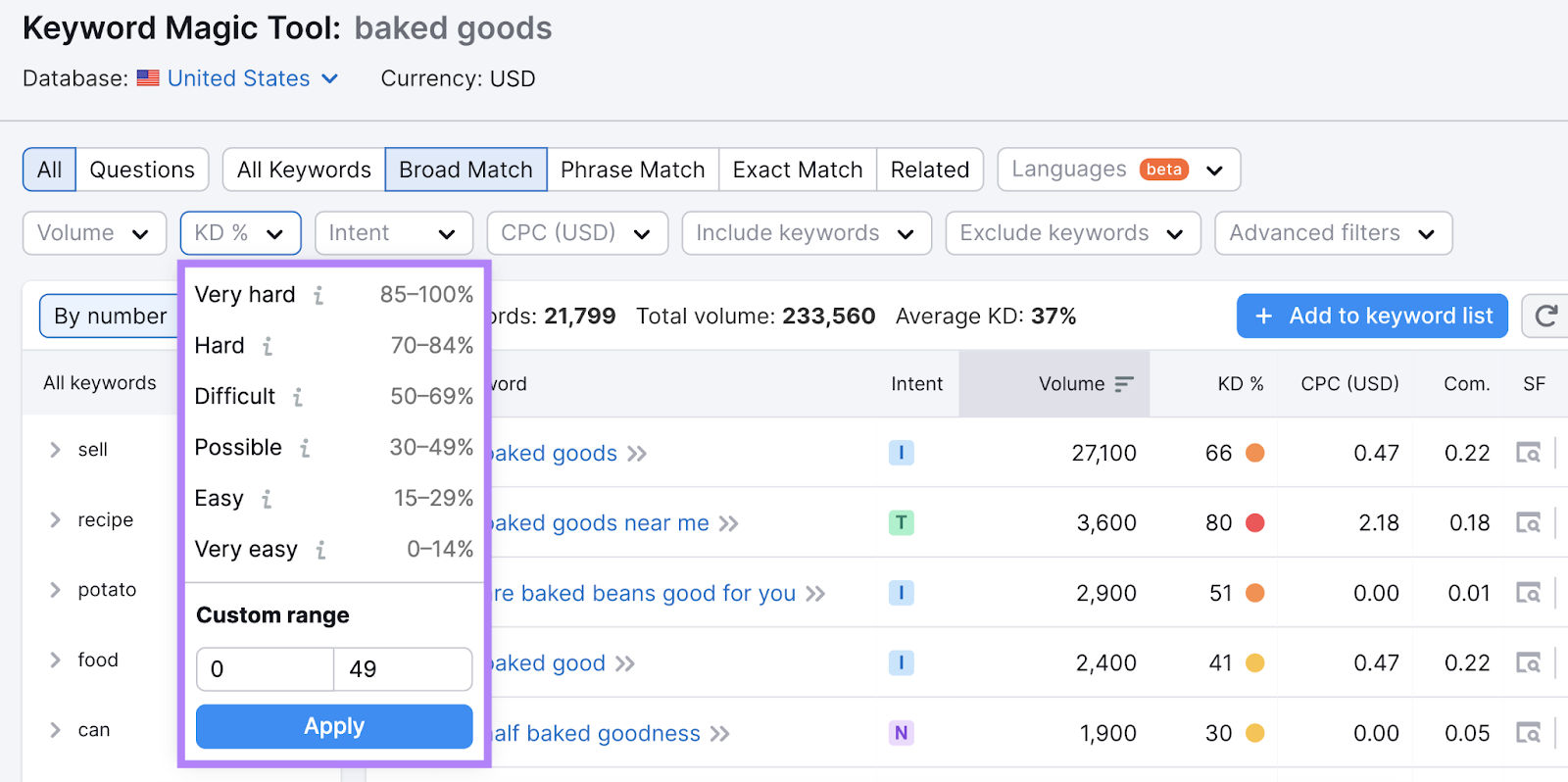
To niche down the results even further, click “recipe” on the left-hand side.
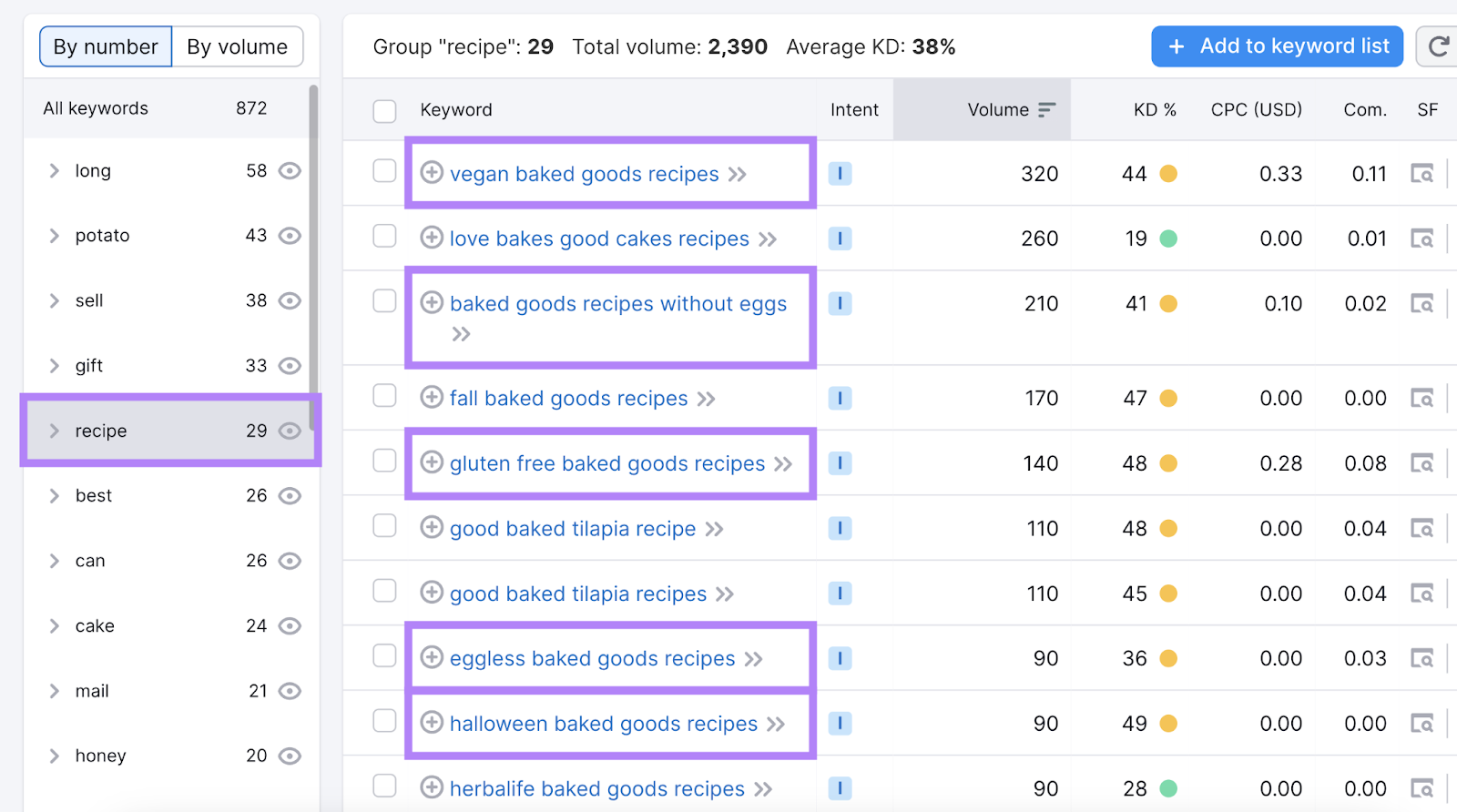
This shows even more niche market ideas within the wider baked goods category. Perhaps you could create specific recipes as blog posts to drive organic traffic. Or sell books with egg-free or seasonal recipes.
You can take this approach with any wide market. Narrowing broad keywords down into niche market ideas.
2. Analyze Trends to Confirm Long-Term Interest
Trends are a useful way to find out the level of interest in a niche market in real time. Analyzing trends can also help you decide if the keywords you found in the previous step are worth targeting as a niche market.
It’s easy to waste resources chasing trends that don’t last. Using tools can help you understand if your niche market idea is likely to be sustainable in the long run.
Google Trends is a free tool for analyzing the popularity of topics over time. Let’s say you decide to go for “baked breakfast recipes” as your potential niche market, based on your keyword research from the previous step.
Enter the keyword into the tool and click “Explore.”
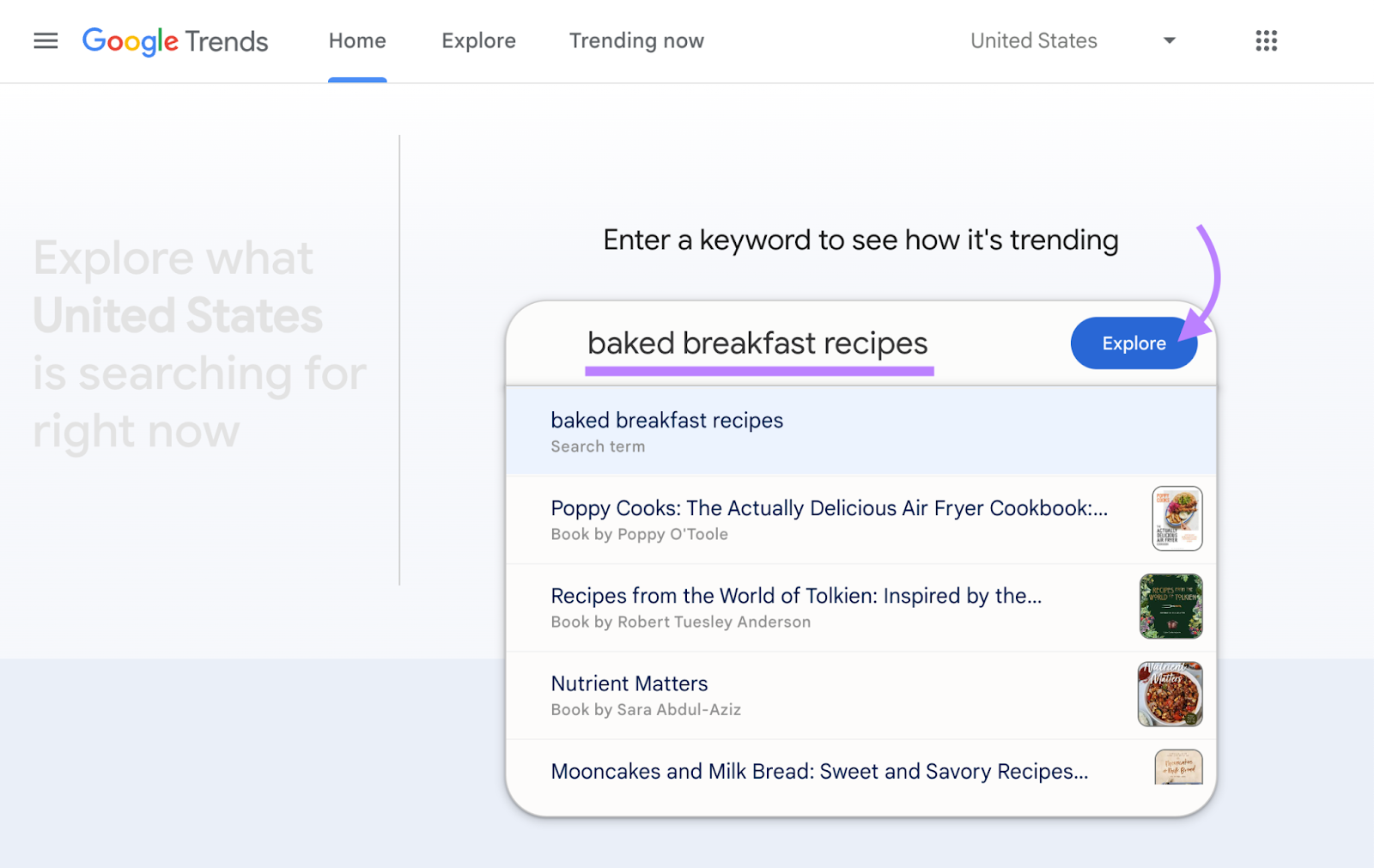
Then choose your target location and time range. We’ll go with the past five years to give us a good idea of this trend’s stability over time.
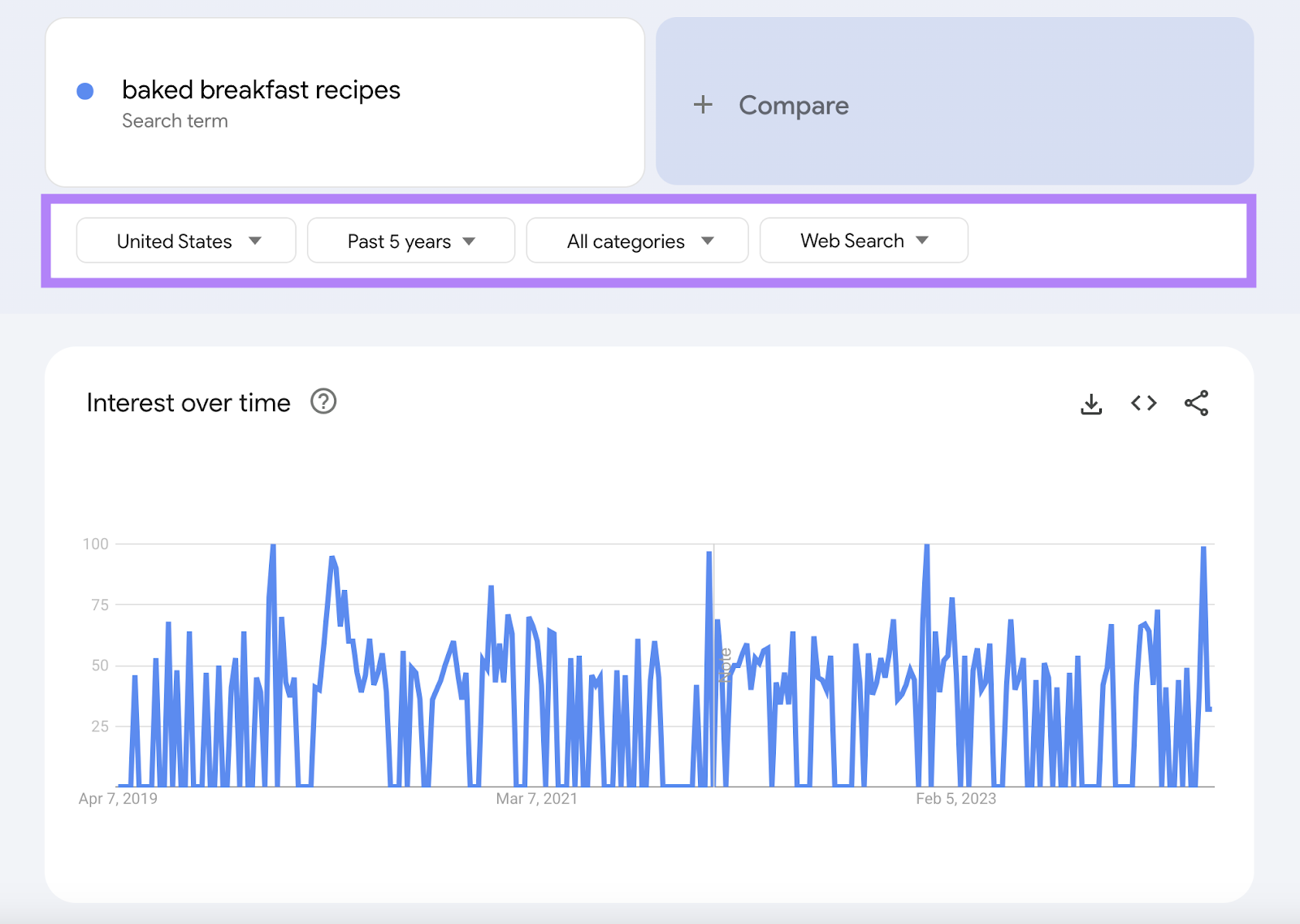
The graph suggests that there has been sustained interest over time for “baked breakfast recipes.” So you decide to use that as a starting point for your niche market.
3. Browse the SERPs
Once you have some ideas of niches you might explore, jump into the search results for related terms. Search engine results pages (SERPs) show you:
- Which businesses already exist in your niche market
- The products or services they offer
- How they position themselves to customers
Not only can SERP analysis help you find competitors (useful for the next section). It can also help you find more opportunities in this niche market.
Let’s say your keyword research and trend analysis has led you to the potential niche market of eco-friendly travel.
Start by typing “eco-friendly travel” into Google’s search bar. You’ll see a list of suggested searches:
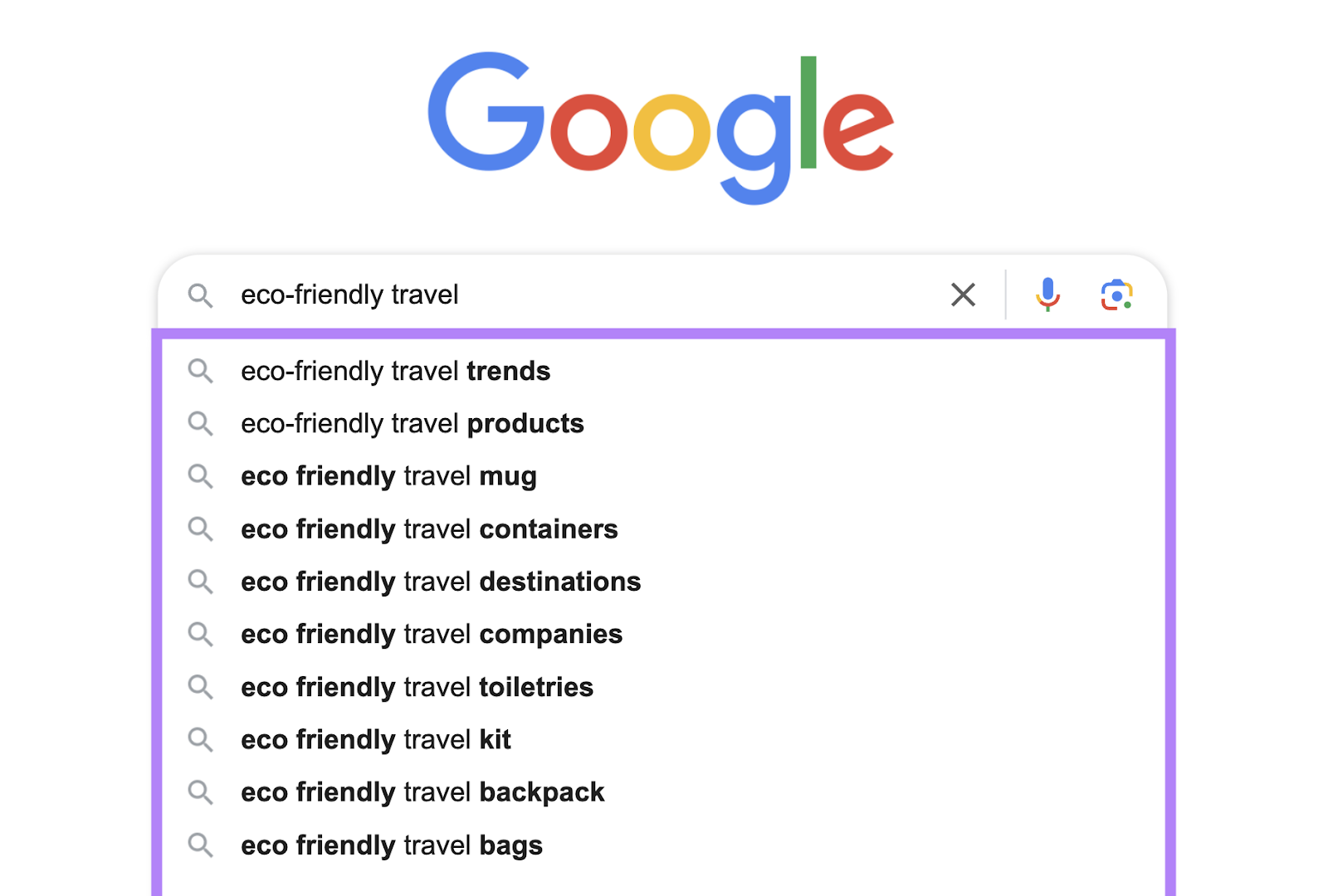
In this example, you can see people often search for eco-friendly travel destinations, products, and companies. These could be ideas for blog posts, of course, but you could also dig deeper into the products searches to see what you could offer to potential customers.
This search term also brings up a People Also Ask (PAA) section:
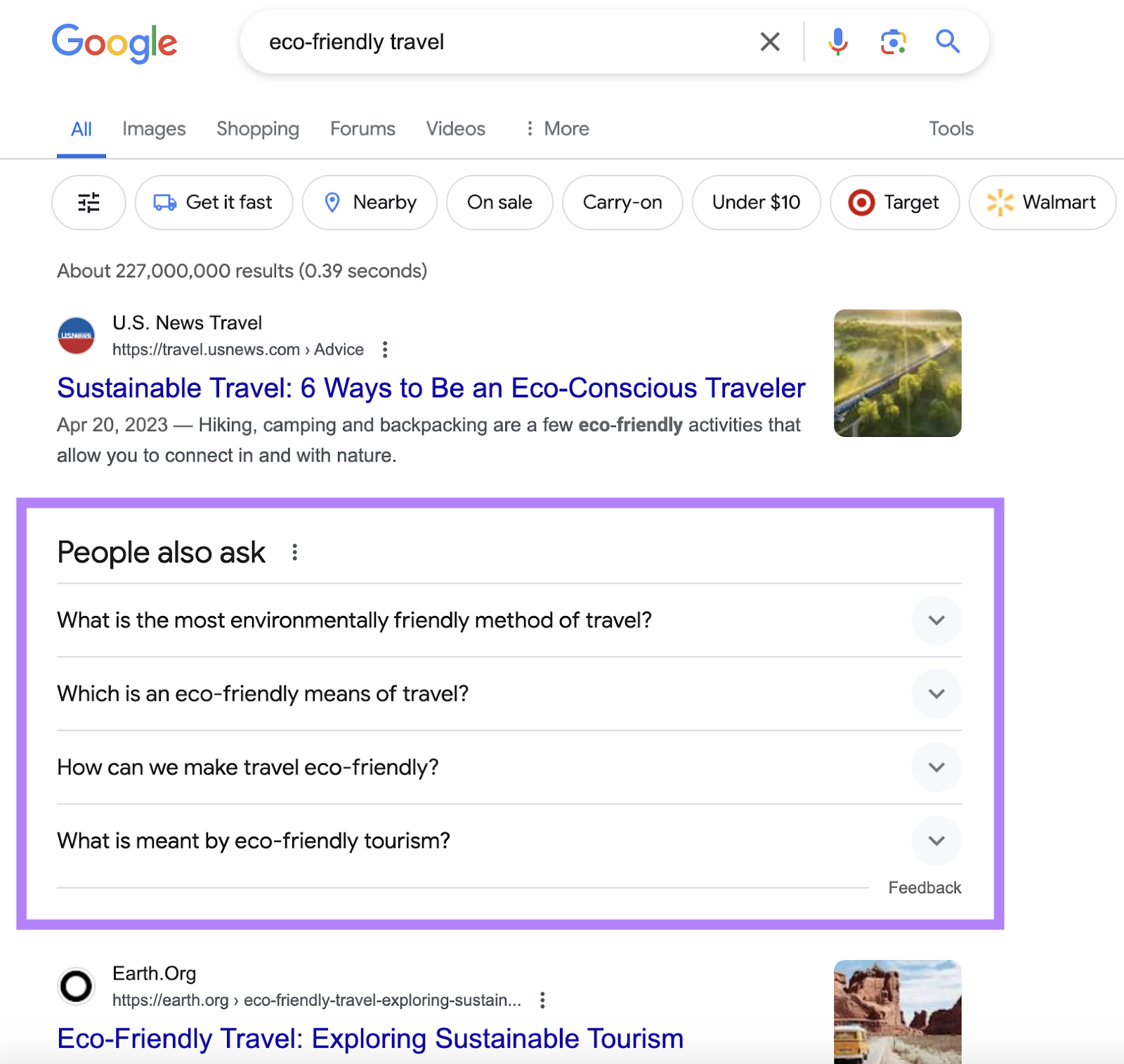
This shortlist of questions gives you an idea of the related topics people are searching for. It could give you ideas for a sustainable travel blog.
But no matter which niche you’re analyzing, these questions provide valuable insight into what your potential customers want to know about this niche market.
Finally, you can also find the related searches section at the bottom of the SERP:
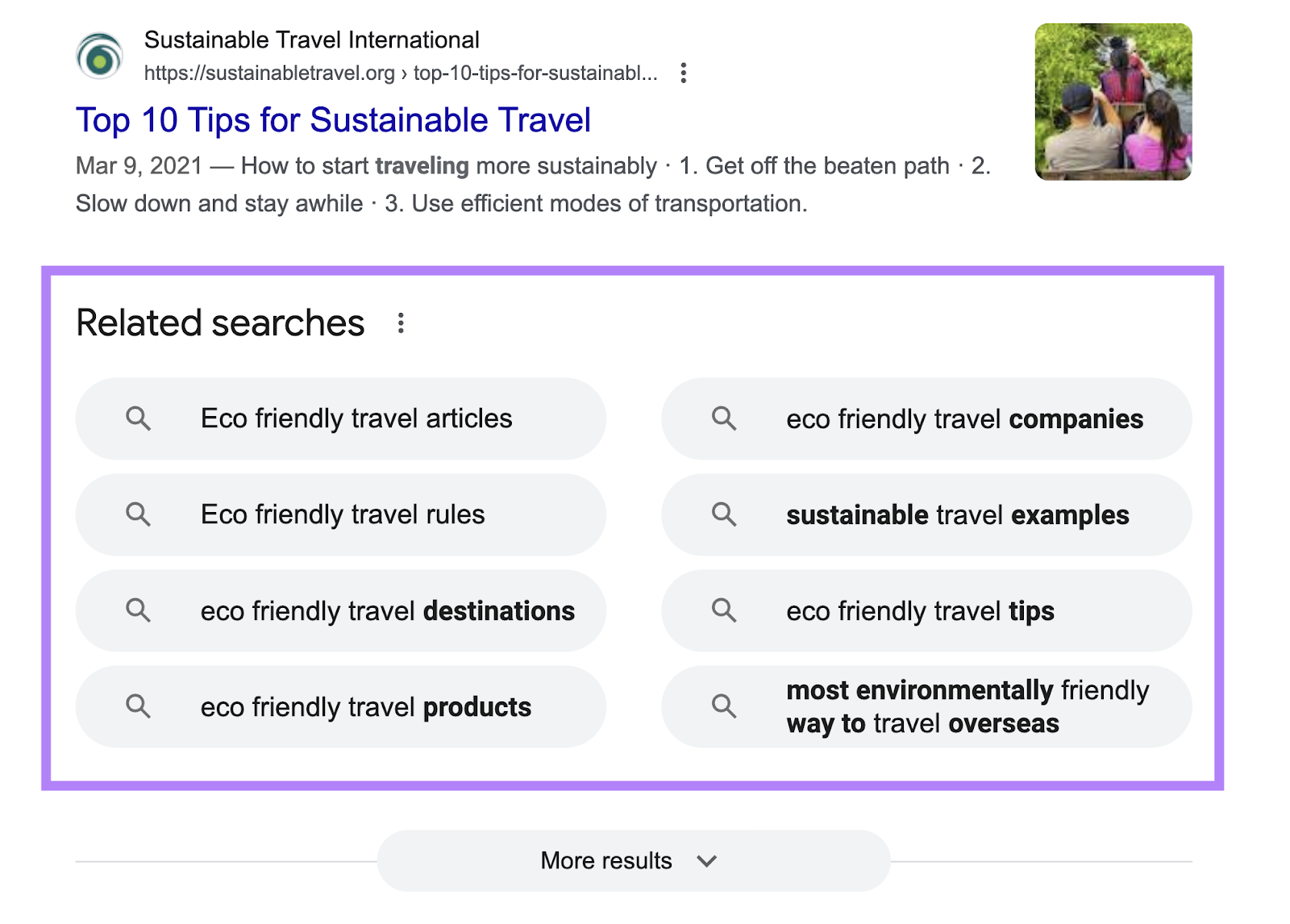
Here we can see people may be looking into things like eco-friendly travel tips. Along with, once again, information about specific products and companies. These could be more ideas for articles or subtopics to discuss in blog posts.
4. Look Into Online Communities
Online communities are another excellent resource to get ideas and conduct customer research on a niche market.
Communities like Reddit provide a platform for people to discuss their experiences, opinions, and preferences related to a specific niche. These forums are extremely valuable because they contain insights and discussions from real people within the market you’re trying to target.
Imagine you wanted to target the remote working niche. There is a subreddit specifically for this: r/workfromhome.
Subreddits are niche communities where people ask questions, share experiences, and have general discussions about that niche. For example, there are lots of questions from this community about noise canceling headphones:
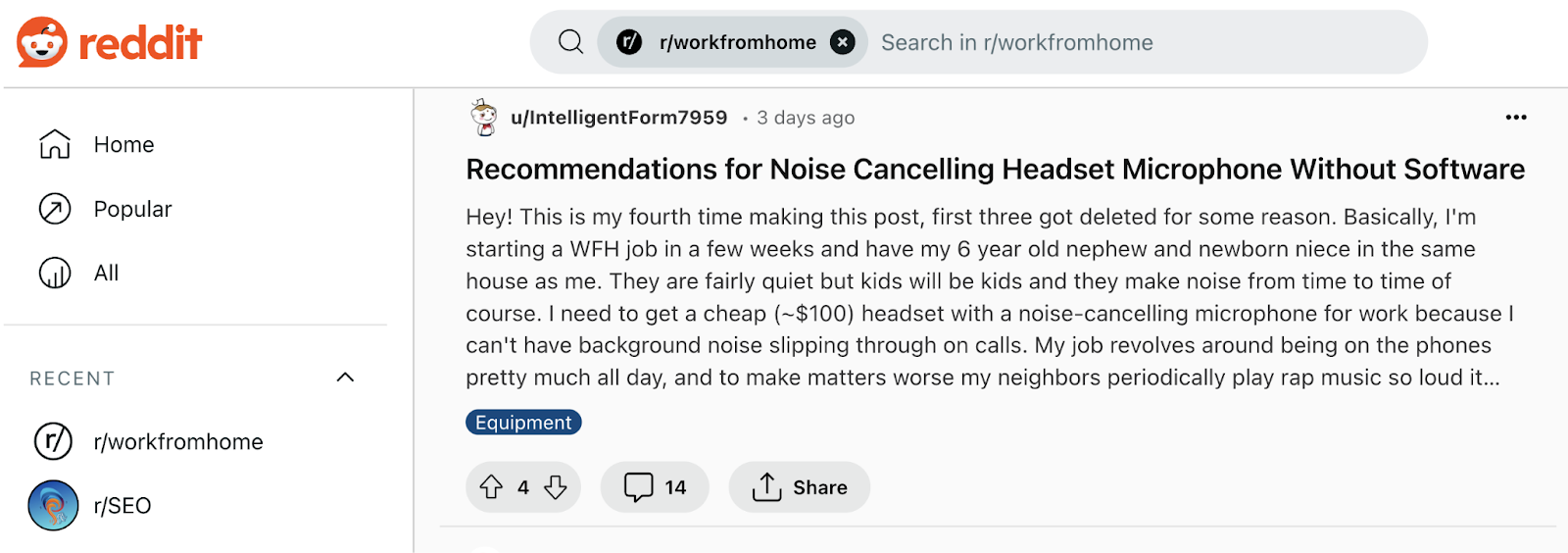
Like the PAA section from the search results, you can also find lots of questions from users in these subreddits. This provides great insights into the problems potential customers face within the niche market.
How to Decide Which Niche Market to Target
Identifying niche markets is the first step. But not all niches you find will be worth pursuing as a target market. Here’s how to choose which niche market is right for your business:
Analyze the Market with Market Explorer
To learn more about your potential niche market, use the Market Explorer tool. This will give you information about:
- Market consolidation: Reflects the division of market share among market players
- Market size: The total addressable market (TAM) along with the serviceable available market (SAM)
- Domains: How many domains there are in this market (effectively your competitors)
- Traffic levels: A measure of how much search traffic there is for this niche market
Hopefully you’ll have a few competitors in mind from analyzing the search results in the previous section.
Once you do, either enter a list of up to 100 into Market Explorer in the “Create List” tab. Or enter one in the “Find Competitors” tab and the tool will find more for you. Then click “Research a market.”

The “Overview” tab is where you’ll see a summary of the market with all the key metrics listed above.
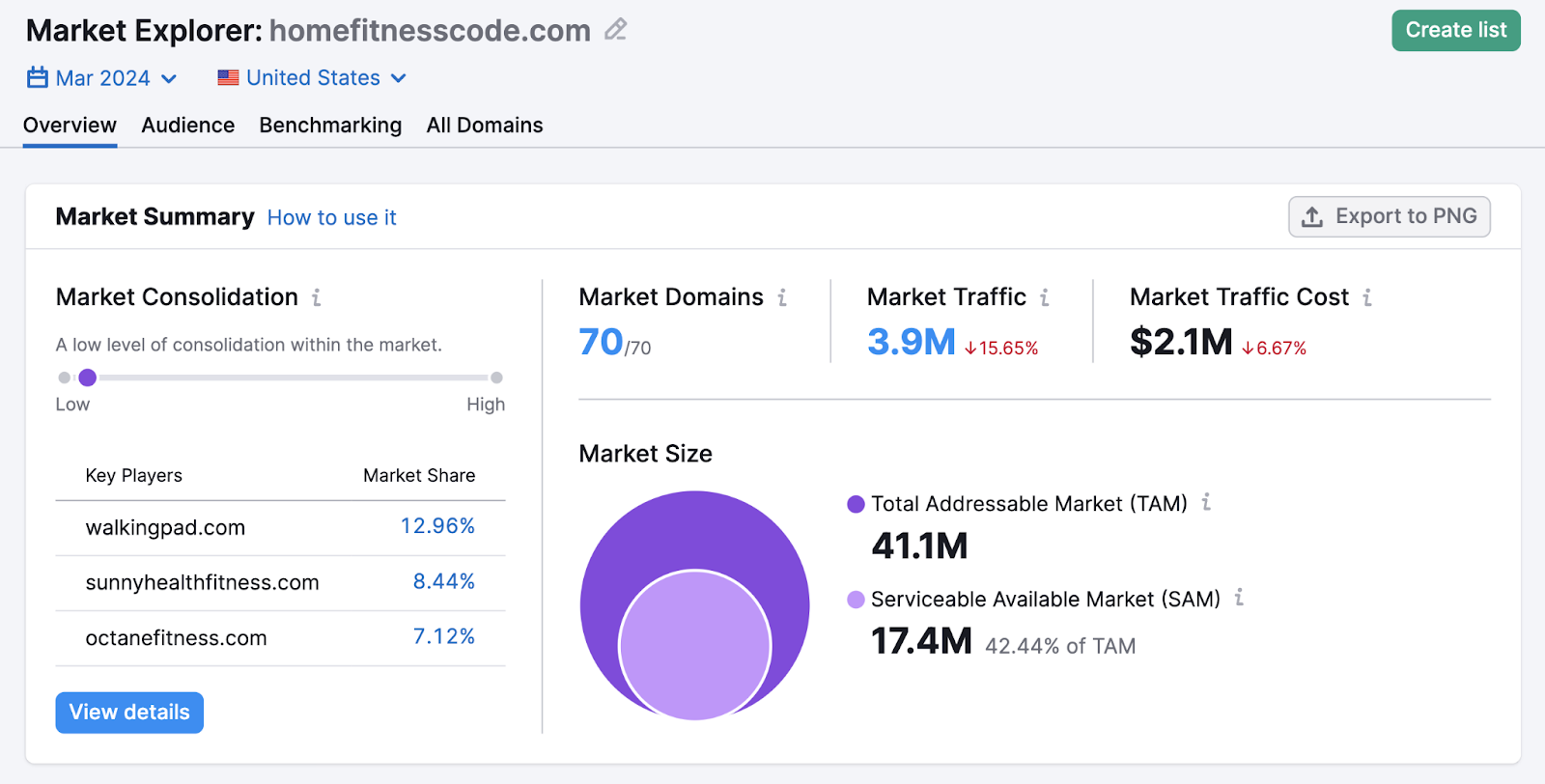
Ideally, you’ll want to find a niche market with:
- A low level of market consolidation
- A low number of competing domains
- High levels of market traffic
Conduct a Competitor Analysis
The Market Explorer tool also gives you insights into which competitors are more established and which ones are newer on the scene.
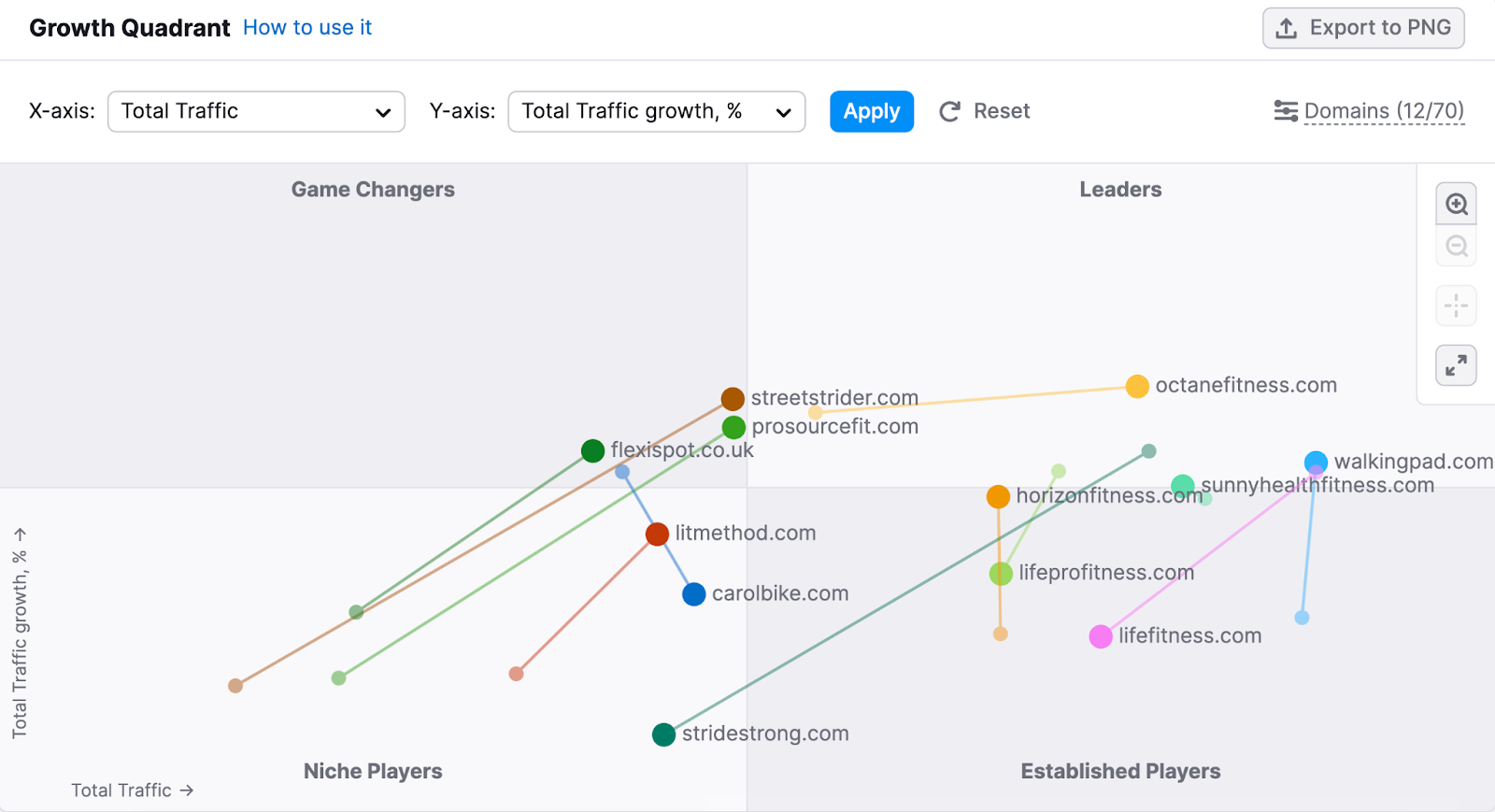
This is a useful way to build a list of competitors you’re most likely to be main rivals with in the niche market. Once you have a list of these, you can then look deeper into those competitors to understand whether you’ll be able to sustainably compete with them in the long run.
One way to do this is to look at the four P’s of marketing for each main competitor:
- Product: How their product meets customers’ needs
- Price: How much their product or service costs
- Place: How their customers find their product
- Promotion: How they advertise to their customers
Do you have or can you create a better product? Will you be able to compete with them on price? Can you reach your audience through the channels they use? Or could you take a different, untapped angle?
Your answers to the first two questions largely depend on your business’s capabilities. But you can gather data around place and promotion using Traffic Analytics.
Enter your competitor’s domain and click “Analyze.” (You can also analyze up to 100 competitors in bulk.)
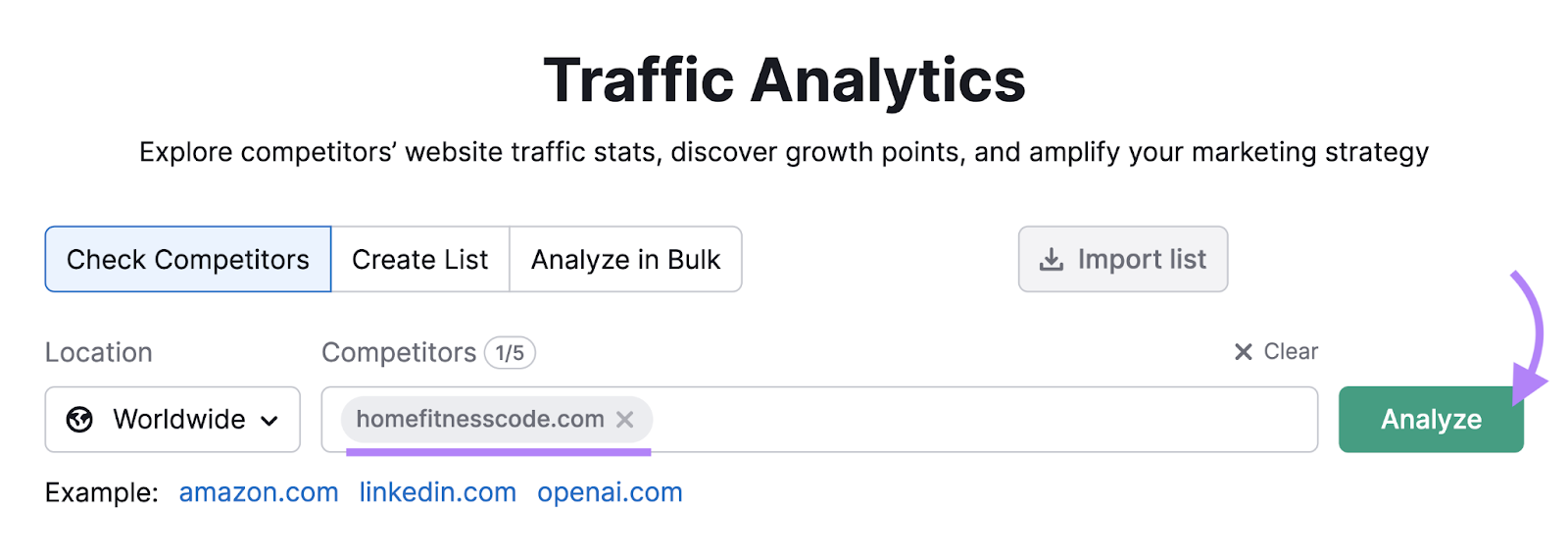
The “Overview” tab shows you details about their traffic, like monthly visits and estimated conversions. But if you scroll down you’ll find the “Traffic Channels by Type” and “Traffic Journey” widgets.
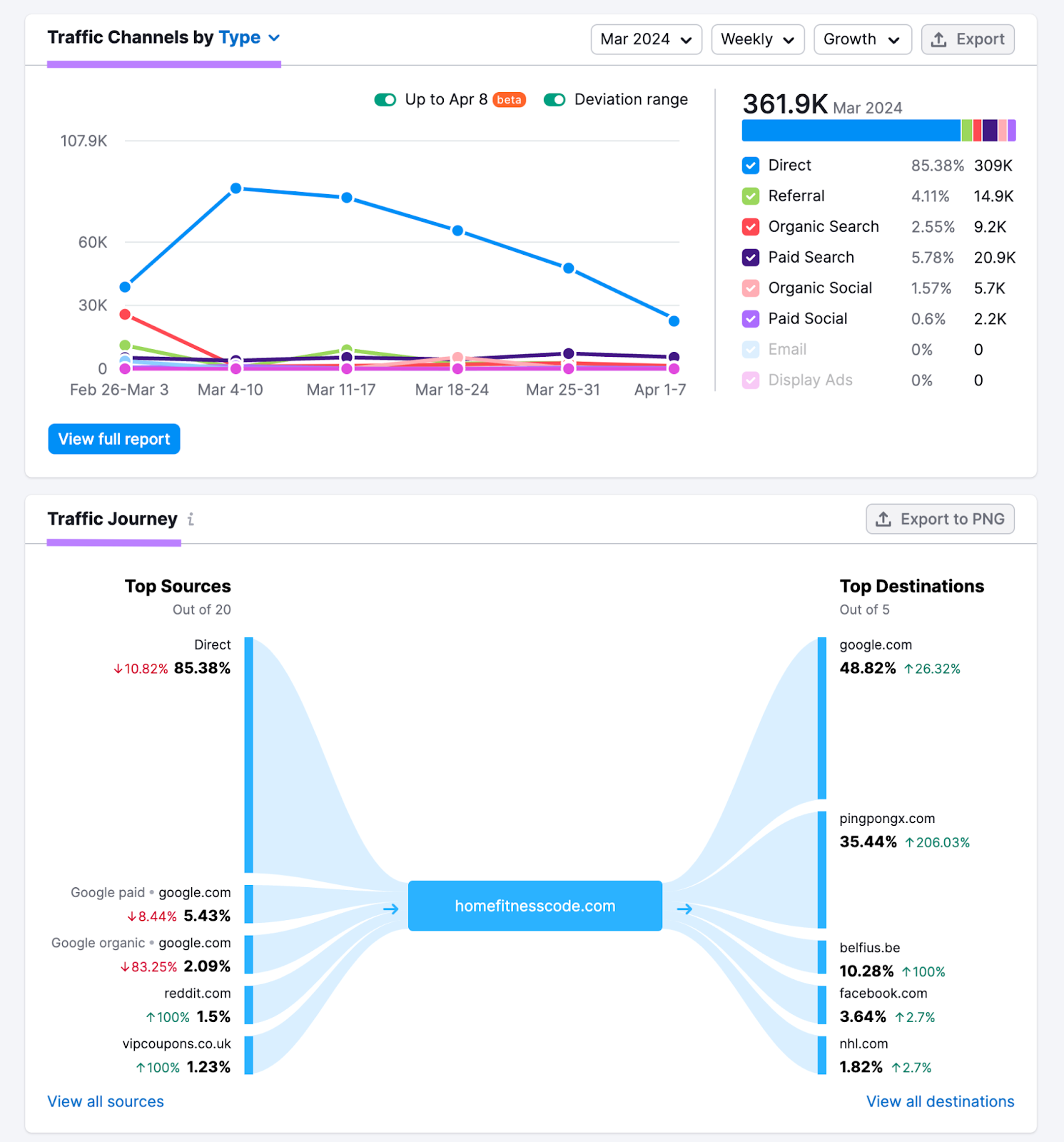
This reveals where your competitor gets most of their traffic from, like organic search or paid ads. And even which websites drive traffic to their site.
For example, the image above shows this competitor drives thousands of visitors to their website via Reddit. So you may want to look into that platform as a viable marketing channel.
Repeat this for your main competitors to understand which marketing channels you might need to focus on. And to find gaps where you could use channels others aren’t yet using.
Test Your Ideas
Testing ideas before making any kind of marketing investment allows you to base future investment on real data.
Here are some ways you can do that:
- Conduct a survey or poll on social media, asking your existing target audience about your new idea
- Take your product to trade shows to gauge demand and gather useful feedback
- Run an ad campaign with a small budget at a targeted section of your market to gauge potential performance
Here’s how Ergo Spout tested their product, an ergonomically designed pouring spout and handle that turns any mason jar into a pitcher.
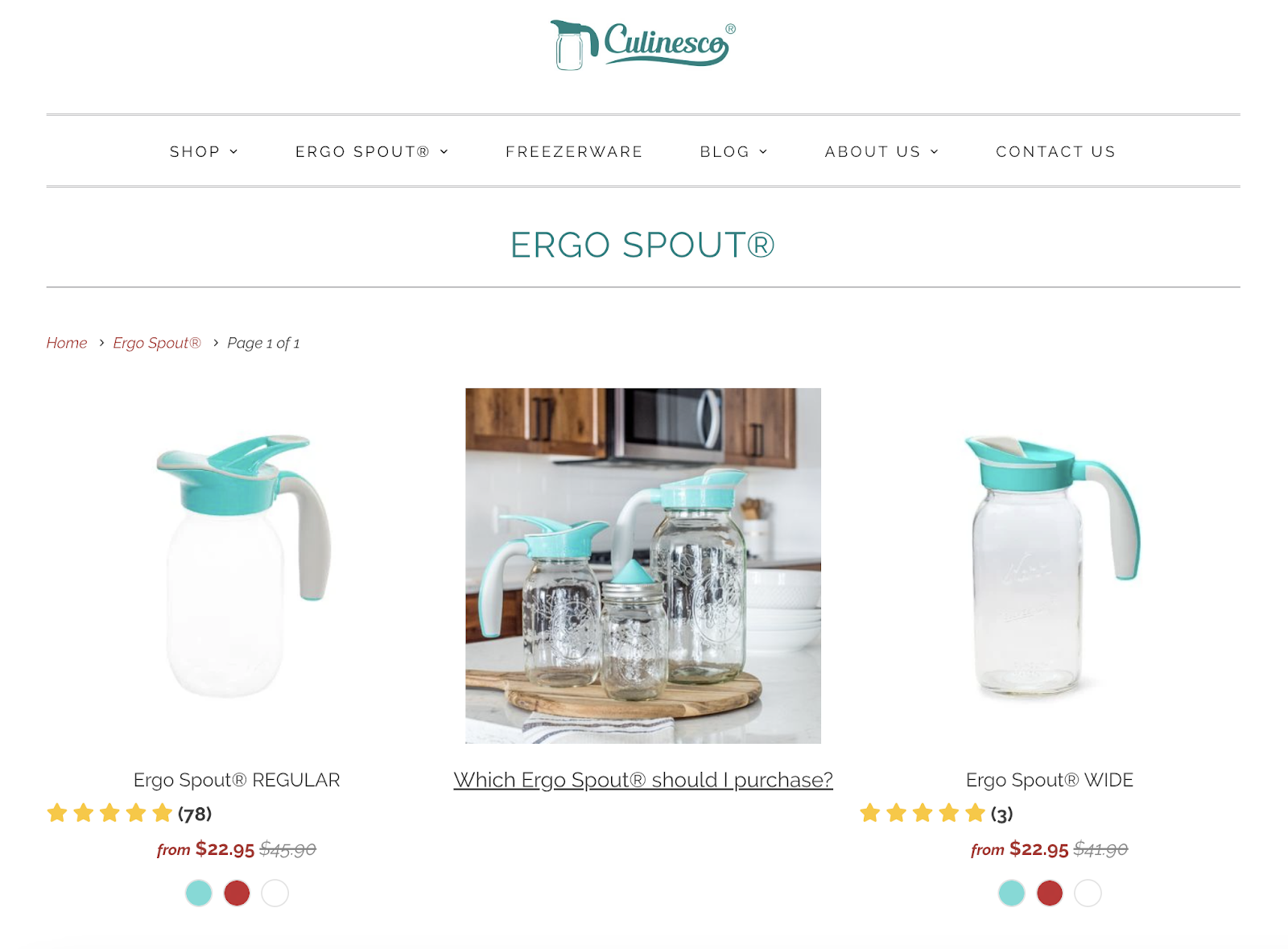
The team created a 3D-printed prototype, then tested it at a local farmer’s market.
This process gave them valuable feedback to improve and gather enough customer interest to justify production.
You often don’t need to create a full-fledged product or service—it only needs to be functional enough to get feedback from potential customers. Then, if you see sufficient demand and a viable route to production, you can invest in your idea with more confidence.
Examples of Niche Markets
Here are five niche market examples to provide some inspiration for your next business idea:
Work-from-Home Fitness
The percentages of employees who work from home at least some of the time increased from 7% in 2015 to 28% in 2023. This opened up a variety of new opportunities for niche marketers.
LifeSpan targets the niche market of remote workers who want to exercise while working.
They sell treadmill desks—the combination of a treadmill and a standing desk.

This is a great example of a brand capitalizing on cultural shifts to carve out their spot in a niche market.
Plant Parents
The plant parent niche is a subset of the broader gardening and horticulture market. Focusing on the care, maintenance, and cultivation of indoor plants.
One company targeting this niche market is The House Plant Box.

The company sends subscribers new potted plants every month. Each box is tailored to the recipient’s preferences.
It’s a great example of a brand in a seemingly “traditional” industry—gardening—putting a modern spin on their business model.
Ethical Beauty Shoppers
Ethical beauty shoppers prioritize buying sustainable, environmentally friendly, cruelty-free, and chemical-free products. Credo Beauty, for example, is an online clean beauty retailer that offers safe, sustainable, and ethically sourced products.

Credo has built a following within the ethical beauty shopping market. It only lists brands that pass its strict standards. Which caters to a market of consumers that are more conscious of where their products come from—something that’s not exclusive to the beauty industry.
DIY Enthusiasts
DIY enthusiasts enjoy creating and fixing things on their own. They would rather make their own furniture or knit their own scarves than buy them from a store.
Content creators who promote DIY tutorials can tap into this trend. Popular topics include home decor hacks, furniture makeovers, and upcycling clothes. Home RenoVision DIY is a great example of this.
This YouTube channel has more than 3 million subscribers, sharing DIY approaches to common household projects. Helping viewers understand how they might be able to save money by doing things themselves.
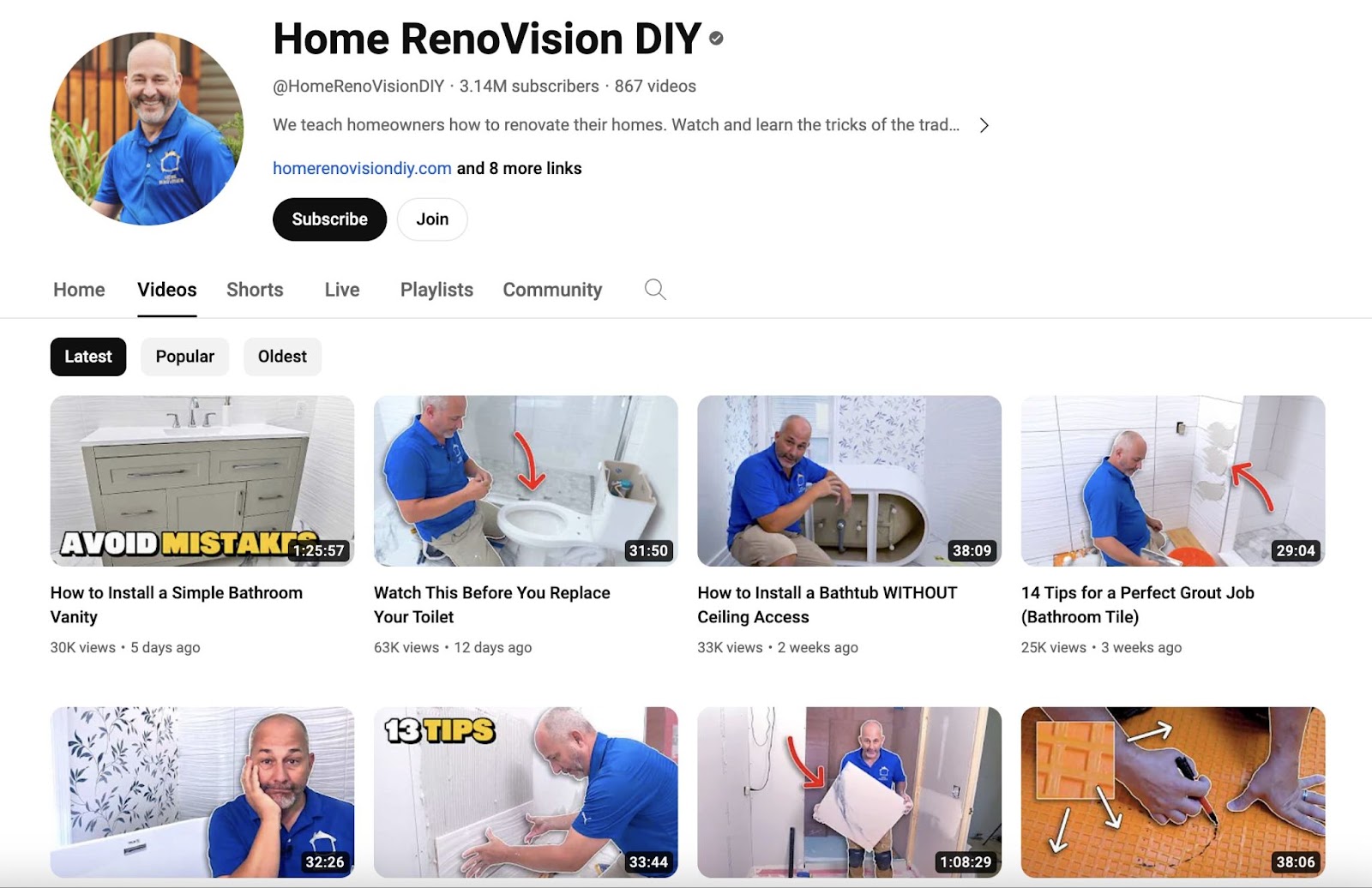
To tap into this trend, you could provide kits, templates, or tutorials to help enthusiasts complete projects.
Or you could offer classes and subscriptions that teach people different skills. Or offer relevant products to help them with their DIY projects.
Mushroom Enthusiasts
Mushroom enthusiasts are passionate about growing their mushrooms, foraging for wild ones, or learning more about the different types of mushrooms.
Gardening brand Back to the Roots sells mushroom-growing kits to tap into this trend.
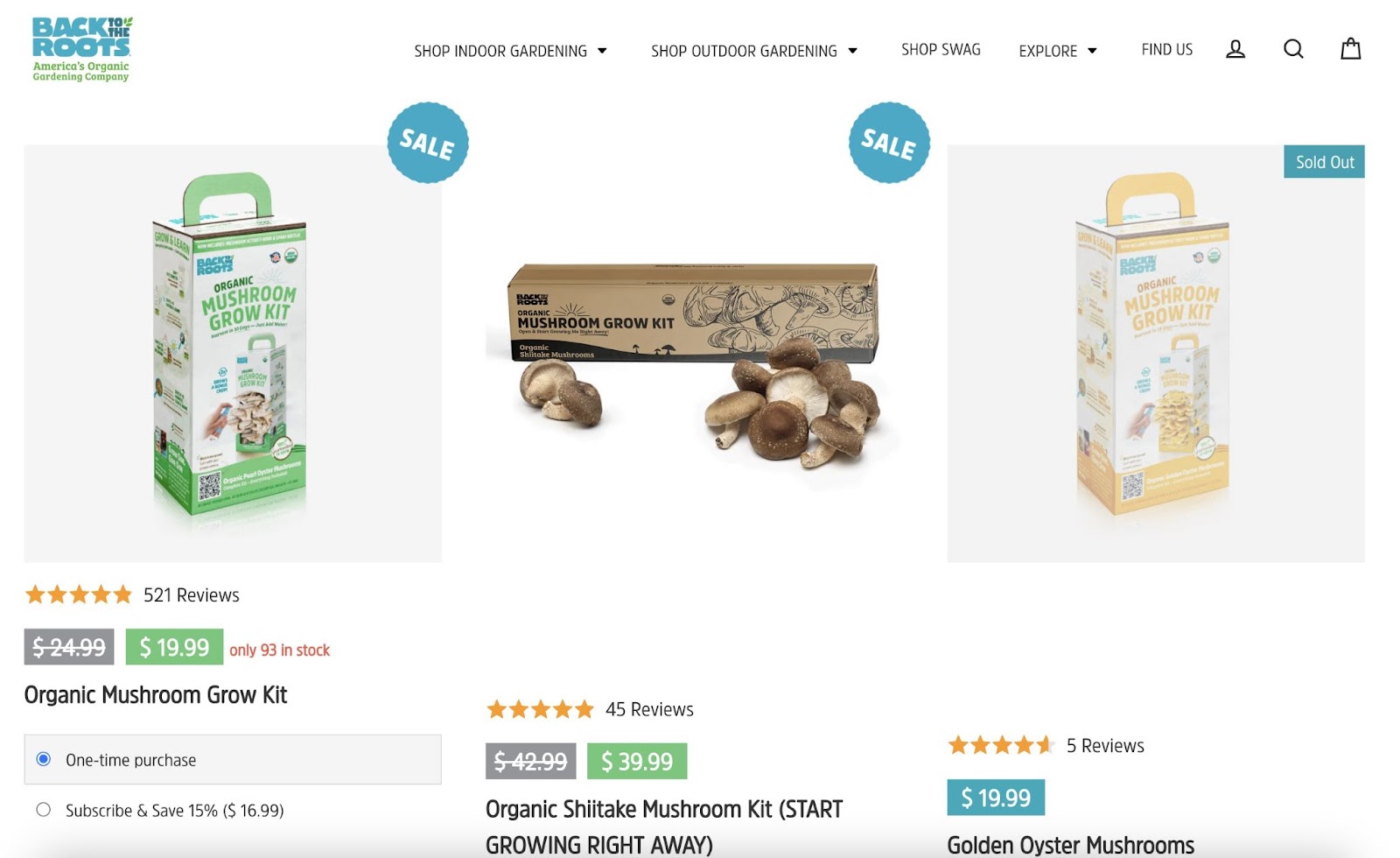
The mushroom market is expected to grow at a CAGR of 9.7% from 2022 to 2030.
More people are becoming interested in the health benefits that different types of mushrooms offer. And are exploring ways to incorporate mushrooms into their daily routines. Making this an attractive niche market for those with the right knowledge, expertise, and products.
Strategies for Niche Markets
Finding a niche and developing relevant products or services is half the battle—the other half is putting them in front of the right people.
Here are three tips to guide your niche marketing strategy:
Engage with Your Audience on Social Media
Provide engaging content, respond to comments and messages, and address customer concerns on social media to build a loyal community. And show customers you care about them.
For example, Sarah Chloe creates personalized jewelry, including necklaces, bracelets, and rings. The team responds to social media comments to show its friendly personality and help potential customers learn more about the brand:

You could also create a Facebook group where your customers can connect and share their experiences with your products. That creates a sense of community and provides valuable insights into your customers’ needs and preferences.
It can essentially function as a private forum. Where you can ask your customers directly what they like about your products and where they think you can improve. This allows you to continuously adapt to changes in your niche market.
Create Targeted Ads
Paid ads are an effective way to target potential customers based on their interests, demographic information, and past behaviors (including purchase history).
For example, Tentree is a sustainable clothing brand that plants trees for every item purchased. And they run ad campaigns on social media:

Words like “sustainable” in the ad copy connect with potential customers who share the brand’s values and are more likely to buy.
Use advertising on platforms like Google and Facebook to create marketing campaigns tailored to specific audiences. Segment your audience into different demographics, like gender, age group, location, and interests.
Find out this data for your target market with Semrush’s One2Target.
Enter your competitor’s domain into the tool and click “Analyze.”
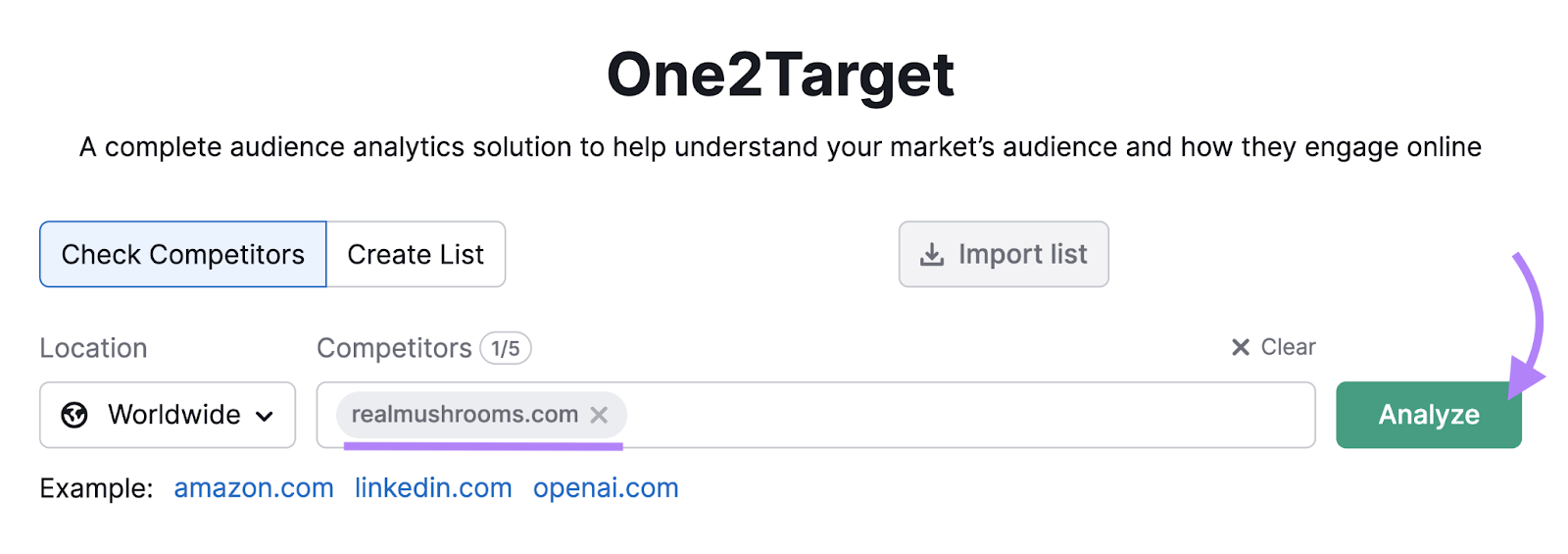
The “Demographics” tab shows you information about your audience’s age, ***, and distribution by country.
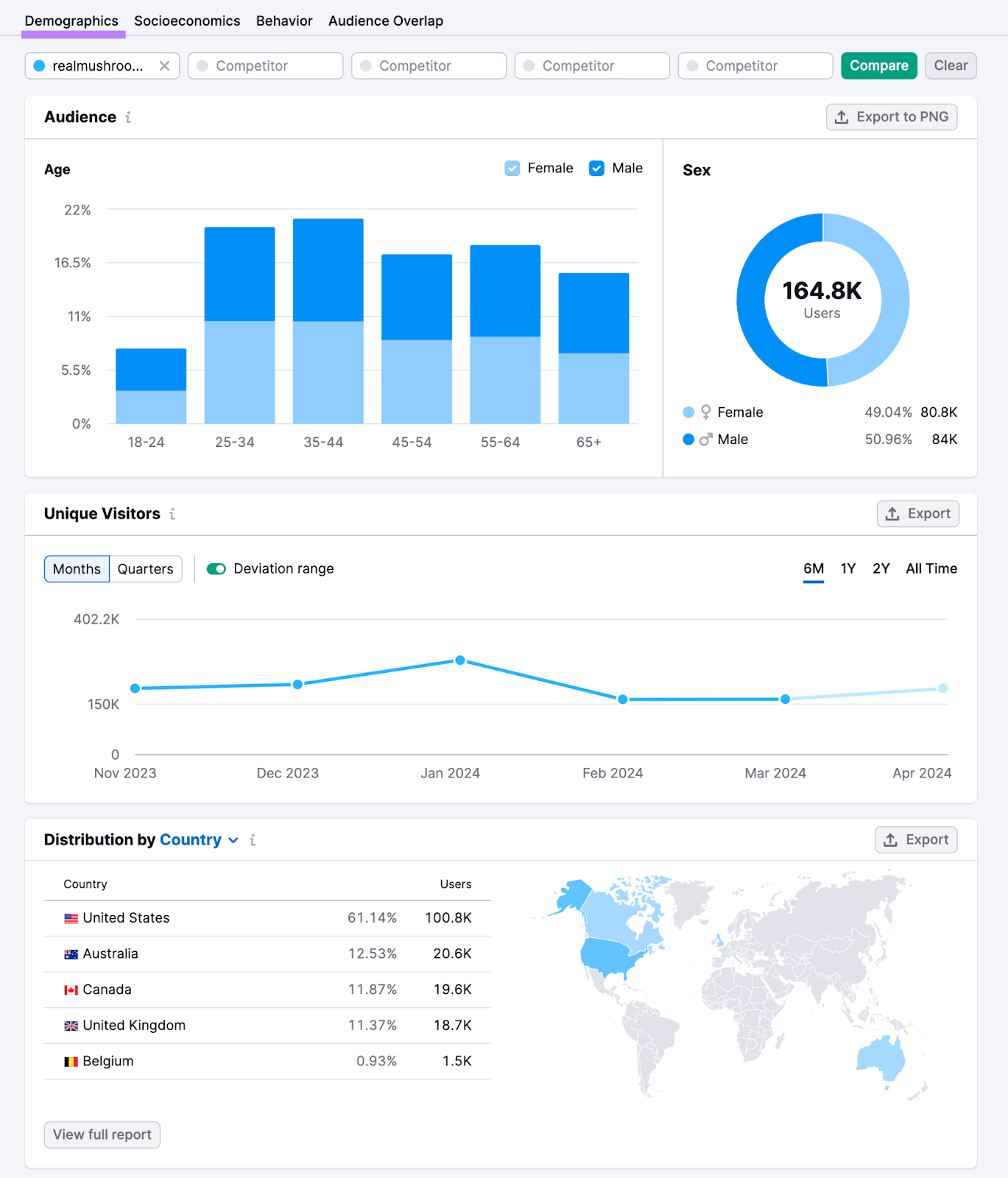
The “Socioeconomics” tab details your target audience’s household size, income level, employment status, and education level.
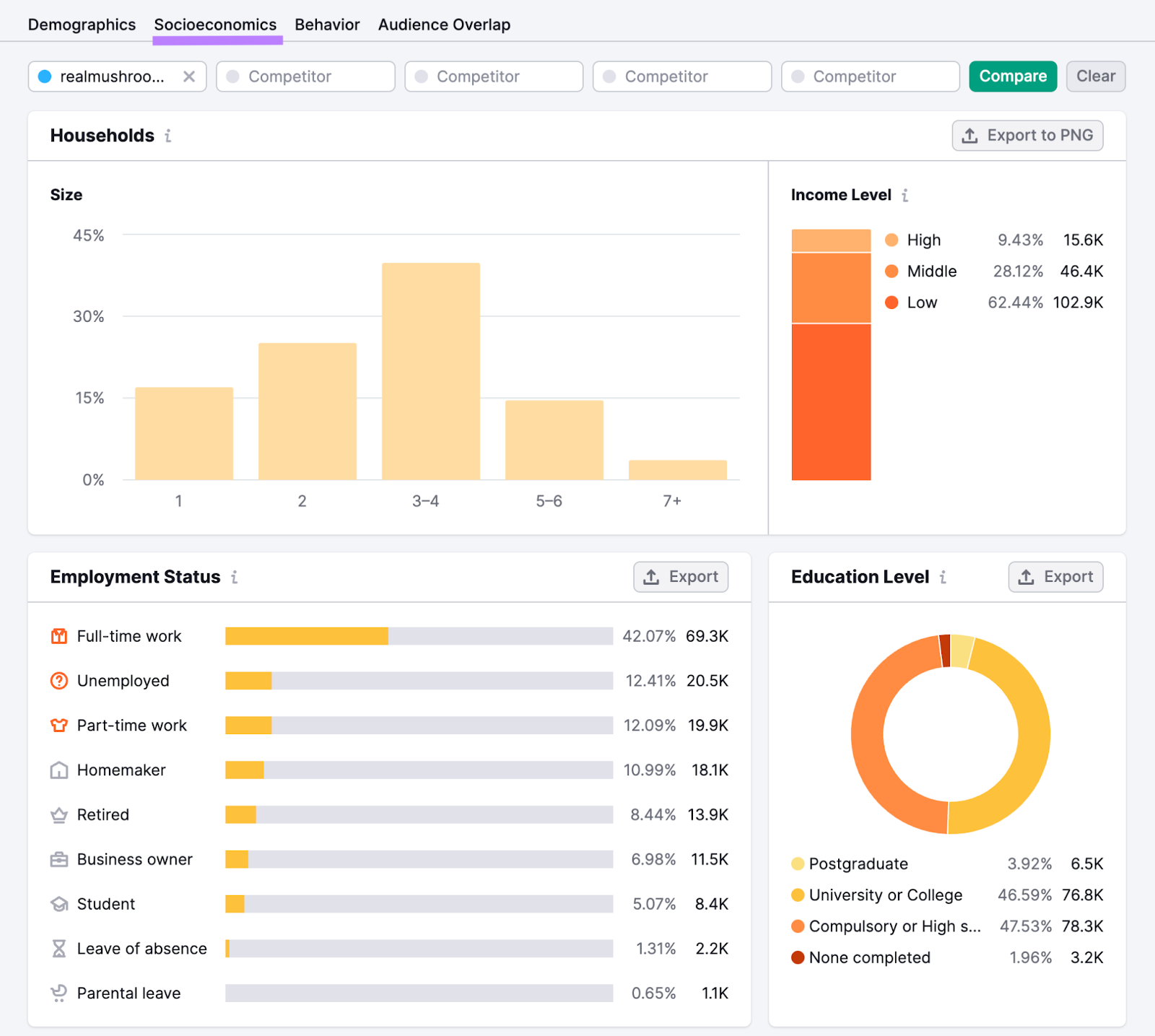
And the “Behavior” tab shows you your target audience’s interests, the devices they use, and the social media channels they visit most often.
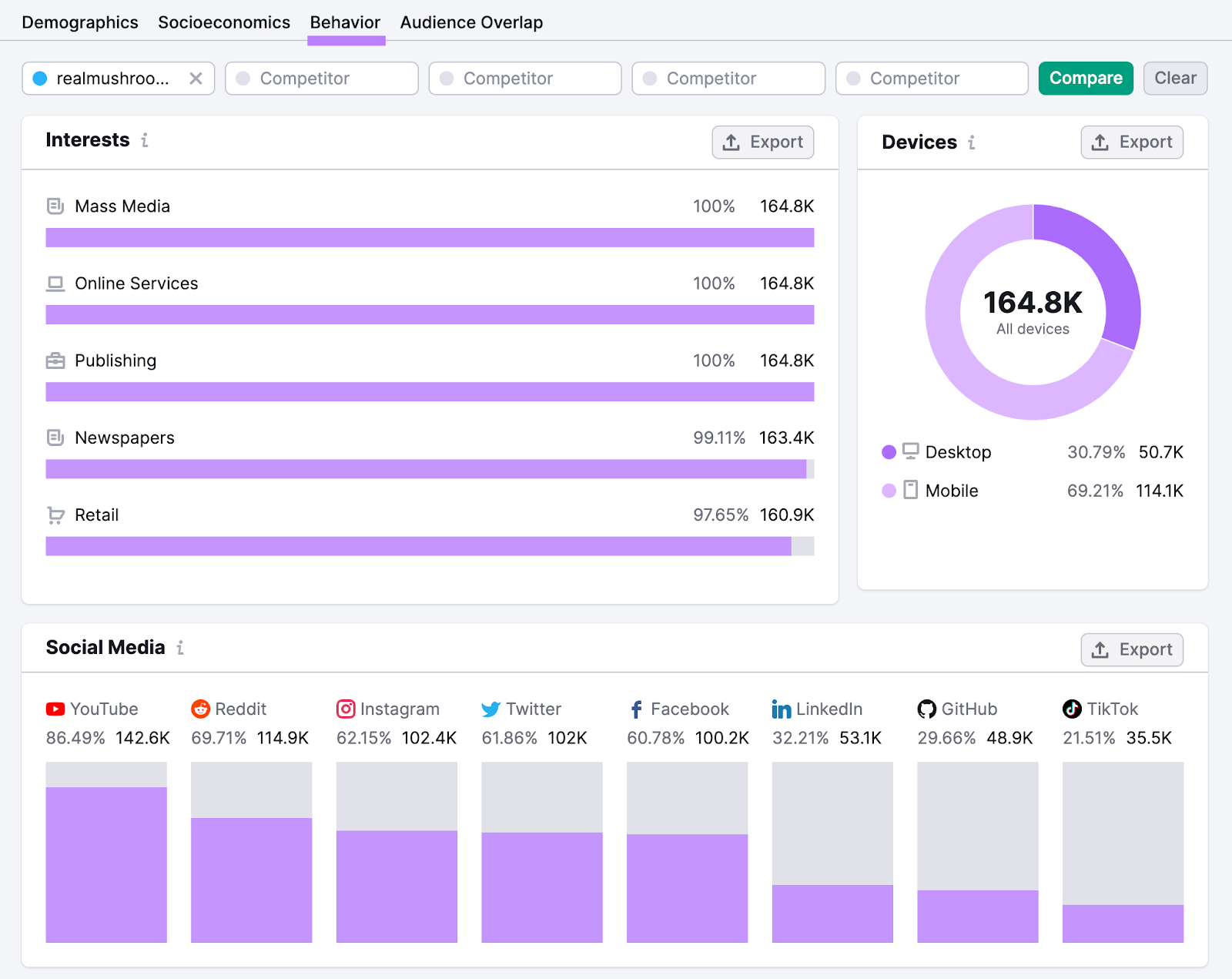
So not only can you learn which demographics to target with your campaigns. But you’ll also learn which platforms to run ads on to reach your target audience.
Taking the audience in the image above as an example, we might want to create YouTube and Reddit ad campaigns. As these are the two platforms on which our potential customers are most active.
Develop Influencer Partnerships
Influencer partnerships are collaborations where an influencer promotes a brand’s products or services to their followers.
Tentree, for example, collaborated with Alicia Haque, an influencer who posts adventurous travel-related content:

Niche brands require niche influencers—a study highlighted that 39% of brands chose nano-influencers with 1K to 10K followers as their most likely partners.
In the same study, 30% opted for micro-influencers, with 10K to 100K followers. Nano and micro-influencers often have higher engagement rates. Making them ideal partners for businesses in niche markets where engagement and brand loyalty are vital.
Further reading: How to Find Influencers for Your Brand (Not Just on Instagram)
Choose a Sustainable Niche Market Based on Real Data
Niche markets represent excellent opportunities to bring your specialized product or skills to a passionate audience. But you need to pick a market that can provide sustainable growth over time.
Do this by performing effective market research, monitoring trends, and analyzing competitors. Semrush’s .Trends toolkit makes each step of the process easy and efficient.
Including:
Source link : Semrush.com
